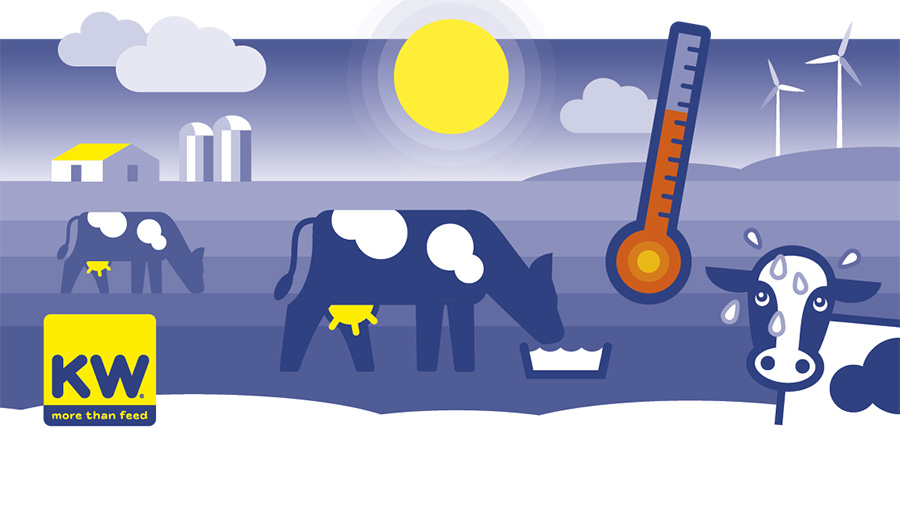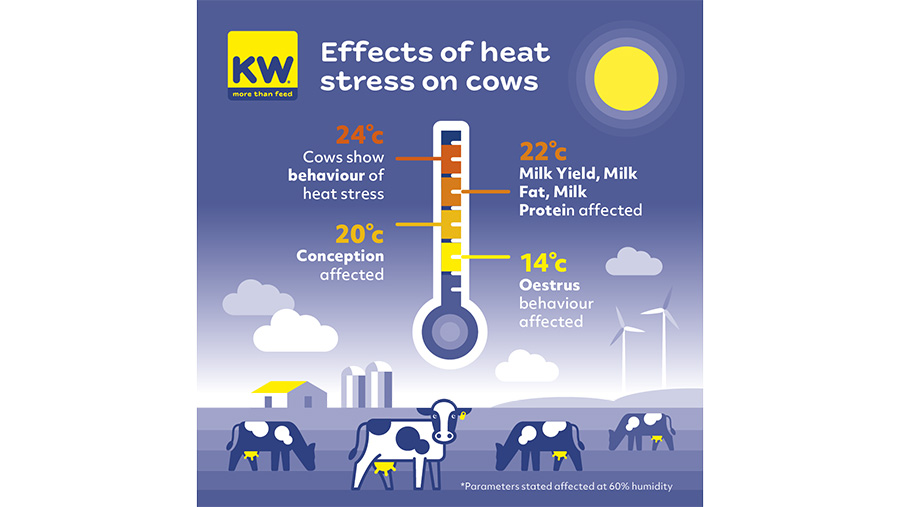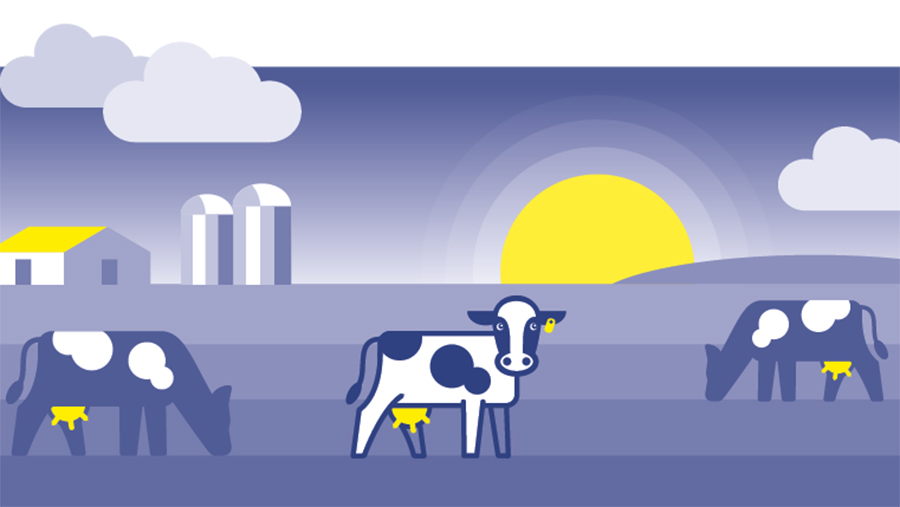Advertiser content
Minimise heat stress and improve milk production efficiency this summer
 © KW Feeds
© KW Feeds With the first heatwave of the summer seeing temperatures top 30°C in parts of the country, and predictions that we can expect more of the same over the coming months, dairy producers are being reminded of the risks of heat stress in cows, and the potential significant impacts on health, performance and fertility.
“In the UK temperatures tend to fluctuate and top in the 30s, but even with these fluctuations, humidity tends to remain above 60% from April all the way through to October, meaning that heat stress remains a risk even at more moderate temperatures,” explains KW Feeds ruminant technical manager, Charlotte Ward.
“While we have seen extremes in the early part of June and can expect more, it must therefore not be forgotten that cattle can be affected by heat stress at far lower temperatures than those recently experienced.
“Crucially, fertility can be affected well before cows show any behaviour of heat stress, or before production is impacted,” she adds.
Ms Ward advises to take precautionary steps to minimise the risks, preparing five ‘top tips’ to help guide the dairy farmer.
Provide adequate drinking water
At least 15% of the herd should be able to drink at the same time, so allow for adequate trough space. Also, check refresh rates and watch cows in the afternoon when water points are under pressure. Cows drink between 60-120 litres per cow, per day, so provide fresh, clean water to encourage intakes.
Apply careful herd management
Reduce stocking density where possible and make sure shading is available for grazing animals. Consider grazing at night.
Adopt building management procedures
Opening vents or shed sides can improve ventilation, being sure to clear away anything blocking airflow. Carefully consider the placement of fans.
Adjust feed management
Mix rations just before feeding out, so feed is always fresh. Adjust volumes if required and clear away refusals. For housed cows, feed 60% of the ration between 8pm and 8am.
Change ration formulations
Dry matter intake is reduced in periods of heat stress, so to maintain the cow’s nutrient intake, the nutrient density of the diet needs to be increased, and the ration made as palatable as possible.

© Original Photo: Cargill
Planned ration formulations
KW advises feeding high quality forages or high energy forage replacers, and to feed a greater ratio of concentrates to forage, as part of a carefully planned ration formulation.
“Forage produces seven times more heat than concentrates, so feed a greater ratio of concentrates to forage” explains Ms Ward, “but ensure a good quality digestible fibre source such as sugar beet feed or soya hulls is fed to maintain rumen health.
“Your KW nutritionist can advise on the best ways of achieving the desired ration formulation and getting best results. For example, introducing liquid or moist feeds such as molasses, C*Traffordgold or brewers grains as a forage replacer, will also improve palatability, drive intakes and reduce sorting,” she adds.
Ms Ward advises to avoid excess rumen degradable protein (RDP) as this takes energy to excrete, and ensure an adequate supply of by-pass protein (DUP). The British rapeseed expeller NovaPro is a good option, with its higher DUP:RDP ratio.
As a concentrated energy source with a low heat increment of digestion, it is also advised to feed a protected fat, such as the high C-16 rumen-protected fat Butterfat Extra, particularly if milk supply contracts have a minimum butterfat threshold.
“You could also consider a rumen buffer and heat stress package to improve cow hydration, salt balance and to support fertility,” continues Ms Ward.
“We can advise on suitable formulations to support performance and fertility, while avoiding digestive disorders during heat stress conditions,” she adds.
Improving efficiency of milk production at grass
Feeding cows at grass during the summer months provides a welcome opportunity to reduce feed costs, but does bring with it challenges that must be overcome to maintain and improve milk production.
“Even the best quality swards grazed under good conditions will only realistically deliver maintenance plus 15-20 litres/cow, therefore cows are at risk of negative energy balance and may struggle to maintain higher yields,” explains Ms Ward
Grass swards can also contain a high sugar percentage and this excess sugar in the grass, coupled with low effective fibre (peNDF), can lead to a large fall in ruminal pH.
When the pH of the rumen falls below pH 5.8, fibre digesting bacteria numbers deplete and the digestion of the fibre is impaired. These drops in rumen pH associated with high sugar and low peNDF are directly correlated to milk fat depression (MFD).
“Feeding the live yeast Vistacell and buffer Acid Buf as part of the daily buffer feed for grazing cows, can help to manage highly digestible grass and reduce risk of SARA and milk fat depression,” explains Ms Ward.
“Vistacell is a specifically selected strain of saccharomyces cerevisiae used to optimise rumen conditions and significantly improve performance.
“By using Vistacell, the rumen is conditioned to promote growth of fibre digesting bacteria due to the yeast’s natural ability to remove oxygen and helping to use up the excess lactic acid,” she adds.
Acid Buf, meanwhile, is an efficient, effective natural rumen buffer derived from calcareous marine algae and is a source of highly bioavailable Calcium and Magnesium. It supports the cow’s natural buffering capacity, maintaining the rumen pH above the critical threshold of 5.8 to reduce the risk of SARA.
“Stabilising rumen pH for over eight hours, Acid Buf optimises rumen pH due to its ability to provide twice the buffering capacity than traditional buffers,” says Ms Ward
With producer margins under pressure, making the most of grazed grass will be crucial. Using Vistacell and Acid Buf in combination can help increase feed efficiencies,” she concludes.

© KW Feeds
Provided by
At KW, we’re proud to support our customers to achieve sustainable performance through unrivalled market expertise and a product offering second to none. We pride ourselves on being a feed and nutritional services partner to some of Britain’s top-performing farms.
